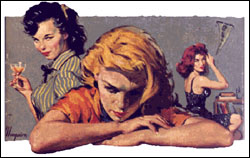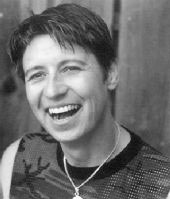CAN WE TALK? Surenow. Now, of course, film and books are so specific, explicit, and graphic that sometimes it’s hard to think straight. But not too long ago, in the mists of time before Stonewall, a different language was spoken. A code developed so that certain types of womena friend’s mother called them “those outdoorsy women”would be able to recognize, um, certain types of women. Here’s a quick primer charting the transition from secret shame to shameless shagging.
Once: The Children’s Hour, a film made in 1962, which Lillian Hellman adapted from her ’30s play. There’s nothing like a rumor of “sexual perversion” between teachers at a girls boarding school to set a plot boiling. Shirley MacLaine tells Audrey Hepburn: “There’s something in you, and you don’t know anything about it because you don’t know it’s there. I couldn’t call it by name before, but I know now. It’s there. It’s been there ever since I first knew you.” MacLaine promptly hangs herself.
And again: Fried Green Tomatoes, made in 1992, was lavished with awards for its depiction of lesbians in a filmwithout anyone actually saying the L-word. Mary Stuart Masterson and Mary-Louise Parker are a butch-femme couple that is affectionate, close, protective of one another, raising a child, implicated in murdering a man . . . but they never kiss! Supersecret code words: “bee charmer.”
How things change: No more pussyfooting around (sorry). Filmmakers are forthright, beginning with their movies’ titles: The Incredibly True Adventures of Two Girls in Love, I Got That Way From Kissing Girls, and the ultimate dinner-date flick, The Potluck and the Passion (no, we didn’t make that up).
BOOKS, TOO, HAVE existed in a world of innuendo, and if that didn’t do the trick, they had amazingly trashy covers.
Once: Women in the Shadows, Odd Girl Out, The Evil Friendship. Enough said.
And again: The ironic reprinting of pulps The Edge of Twilight and The Other Side of Love by Paula Christian. Strange Sisters: The Art of Lesbian Pulp Fiction 1949- 1969 features more than 200 lesbian pulp book covers in sections such as “Positive Portraits,” “Cliterature,” and “Psycho-Babble.”
How things change: This year’s Maryfield Academy, by Carla Tomaso. A girls school? A teacher accused of sexually harrassing one of her students? In a novel tweaking the paranoia of Hellman’s Hour, Tomaso takes a darkly comic approach and laughs at Sappho’s “shame.”
Now that you speak the language of Lesbos, head confidently “out” into a world divided between beekeepers and “bee charmers.”






